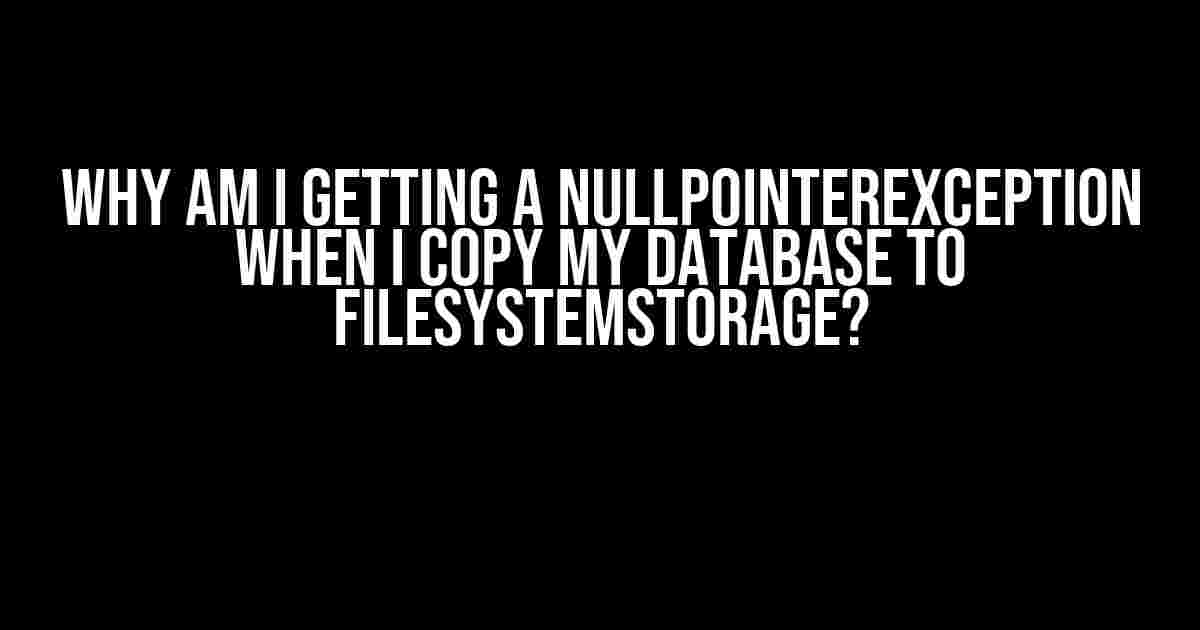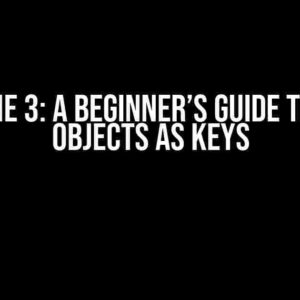Ah, the infamous NullPointerException (NPE) – the bane of every Java developer’s existence! You’re not alone, friend. We’ve all been there, staring at that pesky error message, wondering why our code, which seemed so perfect just a minute ago, has suddenly decided to betray us. In this article, we’ll dive into the mysterious world of NullPointerExceptions and explore why you might be getting one when copying your database to FileSystemStorage.
What is a NullPointerException?
Before we dive into the nitty-gritty of our specific problem, let’s take a step back and understand what a NullPointerException actually is. A NullPointerException is a runtime error in Java that occurs when your program attempts to use an object reference that has no value – in other words, it’s null. This can happen when you’re trying to call a method or access a field on an object that doesn’t exist.
Common causes of NullPointerExceptions
There are several reasons why you might be encountering an NPE. Here are some common culprits:
- Uninitialized variables or objects
- Null object references
- Methods returning null
- Failed database connections
- Invalid file paths or URLs
- Incorrectly implemented null checks
Why am I getting an NPE when copying my Database to FileSystemStorage?
Now that we’ve covered the basics, let’s tackle the specific issue at hand. When you’re copying your database to FileSystemStorage, you might be getting an NPE due to one of the following reasons:
1. Null database connection
Make sure you’ve established a valid database connection before attempting to copy your data. Check your connection string, username, and password to ensure they’re correct. If your connection is null, you’ll get an NPE when trying to access the database.
Connection conn = DriverManager.getConnection("jdbc:mysql://localhost/mydb", "username", "password");
if (conn == null) {
System.out.println("Connection is null!");
return;
}
2. Incorrect file path or URL
Double-check the file path or URL you’re using to copy your database to FileSystemStorage. If the path is invalid or the file doesn’t exist, you’ll get an NPE.
File file = new File("invalid/path/to/file.db");
if (!file.exists()) {
System.out.println("File not found!");
return;
}
3. Null database object
Verify that your database object is not null before attempting to copy its contents. If your database object is null, you’ll get an NPE when trying to access its methods or fields.
Database db = getDatabase();
if (db == null) {
System.out.println("Database object is null!");
return;
}
4. Failed database query
Ensure that your database query is successful and returns the expected results. If your query fails, you might get an NPE when trying to access the resulting data.
Statement statement = conn.createStatement();
ResultSet results = statement.executeQuery("SELECT * FROM mytable");
if (results == null) {
System.out.println("Query failed!");
return;
}
Solutions and Best Practices
Now that we’ve identified the potential causes of the NullPointerException, let’s explore some solutions and best practices to avoid this issue in the future:
1. Initialize objects before use
Make sure to initialize your objects before using them. This includes database connections, file objects, and any other objects that might be involved in the copying process.
Connection conn = DriverManager.getConnection("jdbc:mysql://localhost/mydb", "username", "password");
Database db = new Database(conn);
2. Use try-catch blocks
Wrap your code in try-catch blocks to handle any exceptions that might occur during the copying process. This will help you catch and handle NullPointerExceptions before they cause issues.
try {
copyDatabaseToFS();
} catch (NullPointerException e) {
System.out.println("NullPointerException caught!");
e.printStackTrace();
}
3. Perform null checks
Regularly perform null checks on your objects to ensure they’re not null before using them. This is especially important when working with database connections and file objects.
if (conn != null && db != null) {
copyDatabaseToFS();
} else {
System.out.println("Either connection or database object is null!");
}
4. Use finally blocks
Use finally blocks to ensure that resources are closed and cleaned up, even if an exception occurs. This is crucial when working with database connections and file objects.
try {
copyDatabaseToFS();
} catch (NullPointerException e) {
System.out.println("NullPointerException caught!");
e.printStackTrace();
} finally {
if (conn != null) {
conn.close();
}
}
Conclusion
In conclusion, NullPointerExceptions can be frustrating, but they’re often easy to fix. By understanding the common causes of NPEs, identifying the specific issues in your code, and following best practices, you can avoid these errors and ensure a smooth experience when copying your database to FileSystemStorage. Remember to initialize objects, use try-catch blocks, perform null checks, and clean up resources in finally blocks.
Final Checklist
Before you start copying your database to FileSystemStorage, make sure to:
- Establish a valid database connection
- Verify the file path or URL is correct
- Check for null database objects
- Ensure successful database queries
- Initialize objects before use
- Use try-catch blocks
- Perform regular null checks
- Use finally blocks to clean up resources
By following these guidelines, you’ll be well on your way to avoiding those pesky NullPointerExceptions and successfully copying your database to FileSystemStorage. Happy coding!
Frequently Asked Question
Got stuck while copying your database to FileSystemStorage? You’re not alone! Check out these frequently asked questions to troubleshoot that pesky NullPointerException.
Why do I get a NullPointerException when copying my database to FileSystemStorage?
Most likely, your database connection is null! Make sure you’ve initialized your database helper and opened the database before attempting to copy it to FileSystemStorage.
Have I forgotten to close the database connection?
You might have! Remember to close the database connection after you’re done copying to FileSystemStorage. Leaving it open can cause all sorts of issues, including NullPointerExceptions.
Is my FileSystemStorage permission okay?
Check if you’ve granted the necessary permissions to read and write to FileSystemStorage! If not, you might get a NullPointerException when trying to access the file system.
Am I using the correct file path?
Double-check that file path! Make sure it’s correct and the file exists. If the file doesn’t exist, create it before copying your database. A NullPointerException can occur if the file path is invalid or the file doesn’t exist.
Is my database operation thread-safe?
If you’re performing database operations on a separate thread, ensure that it’s thread-safe! If not, you might get a NullPointerException due to concurrent access issues.


